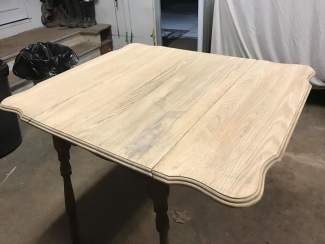


You can use oxalic acid when trying to remove discoloration or water damaged spots. The entire surface needs to be treated and then neutralized with a clean water wash.
Mix 4 oz. per quart of warm water. Wipe the entire surface down with the mixture and allow to dry completely. Rinse table with a clean damp rag. Finish sand with 180 grit followed by the final sanding schedule below. Make sure to wear a dust mask when sanding wood treated with oxalic acid - the dust can irate the nose.
ANSWER: You can design your own custom glazes, washes and varnishes with General Finishes intermixable water based products. See tips and recipes below:
GF Tip: For all of the following mixes, GF recommends the following two steps:
You can design your own custom glazes, stains, washes, and varnishes with General Finishes intermixable water-based products. **Do not mix General Finishes Glaze Effects with General Finishes Water Based Stain (including Pre-Stain Natural) See tips and recipes below.
For all of the following mixes, GF recommends the following two steps:
Q: Which 12 colors will remain in the Milk Paint line?
Make your own custom glazes by mixing with GF water-based paints & stains, or use to dilute GF Glaze Effects colors. Glaze Effects Clear Base is the base used to make General Finishes Glaze Effects.
Yes, there are a couple of ways. Dye Stain Reducer is the clear base that we use when manufacturing General Finishes Dye Stains. The Reducer is made first, then the dye color is added.
It is easy to make your own custom color Dye Stain by adding in 10% increments of Dye Stain color to Reducer until you achieve the color you want. It is not possible to mix too much of our Dye Stain and Reducer together.
Yes, one of its uses is to dilute dye stain colors. Dye Stain reducer is the clear base the we use when manufacturing our dye stains. We make the reducer first, then add the dye color.
It is easy to make your own custom color Dye Stain by adding in 10% increments until you achieve the color you want. It is not possible to mix too much of our dye stain or reducer together.
Additionally, General Finishes Water Based Stains can be mixed into the reducer, which will lighten the color and thin the viscosity so it will penetrate deeper into the wood.
Yes, you can mix similar products together at any ratio to make more color options.
You can also mix with 10% General Finishes Liquid Oil Based Wood Penetrating Stains to obtain a slightly thinner stain than the normal Gel Stain formula.
It's always possible to darken a stained surface, but you cannot lighten a stained surface after the finish has dried.
When the surface is still wet, you can try to lighten the color by scrubbing with mineral spirits. If the finish has hardened, you will need to sand down your current stain and start over or use one of our paints.
You can mix GF Gel Stain colors to create a custom color.
You can also thin Gel Stain with 10-15% mineral spirits.
Always test our color on a hidden area of your project before beginning.